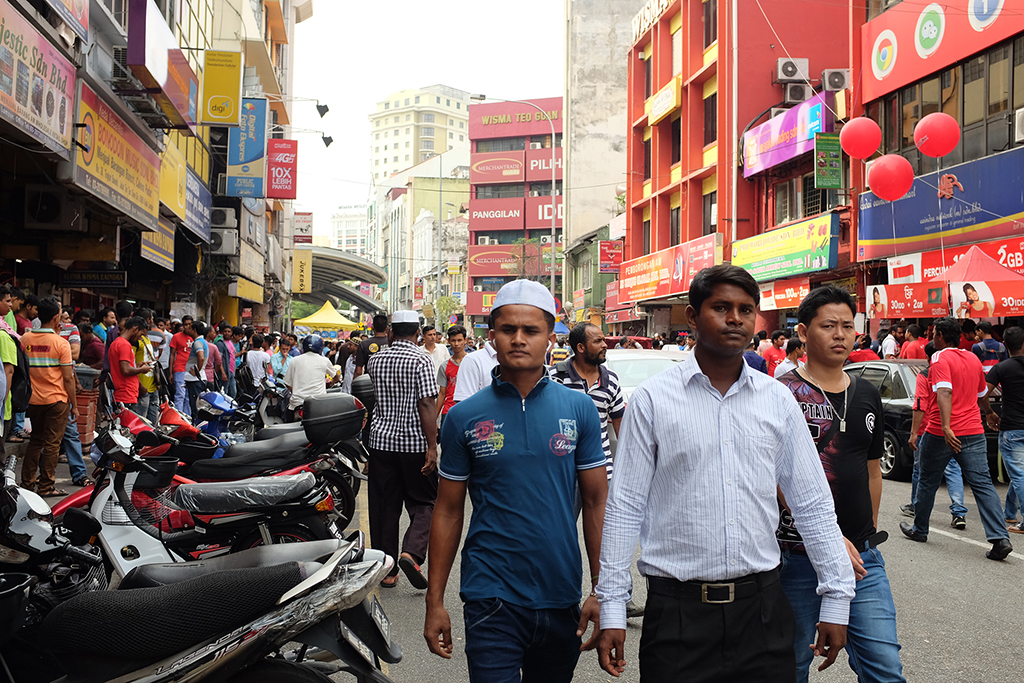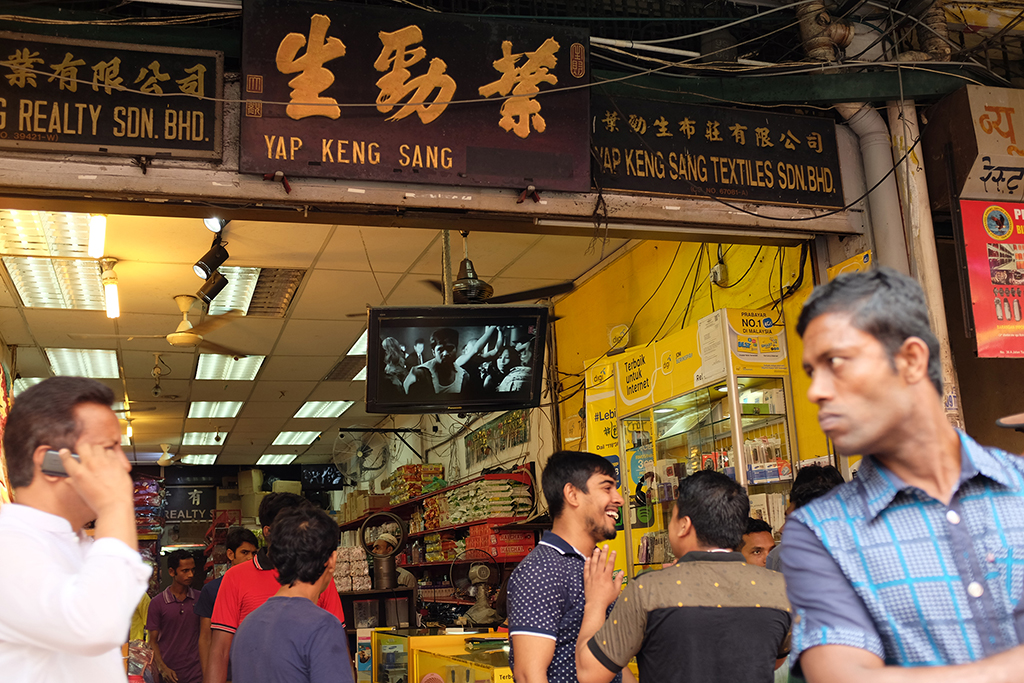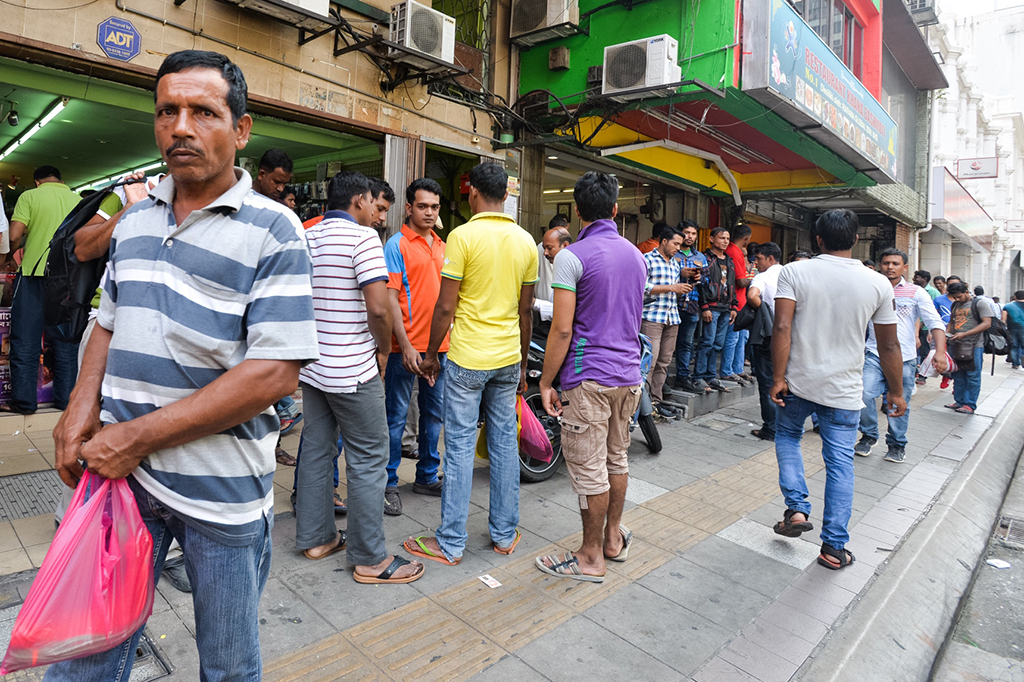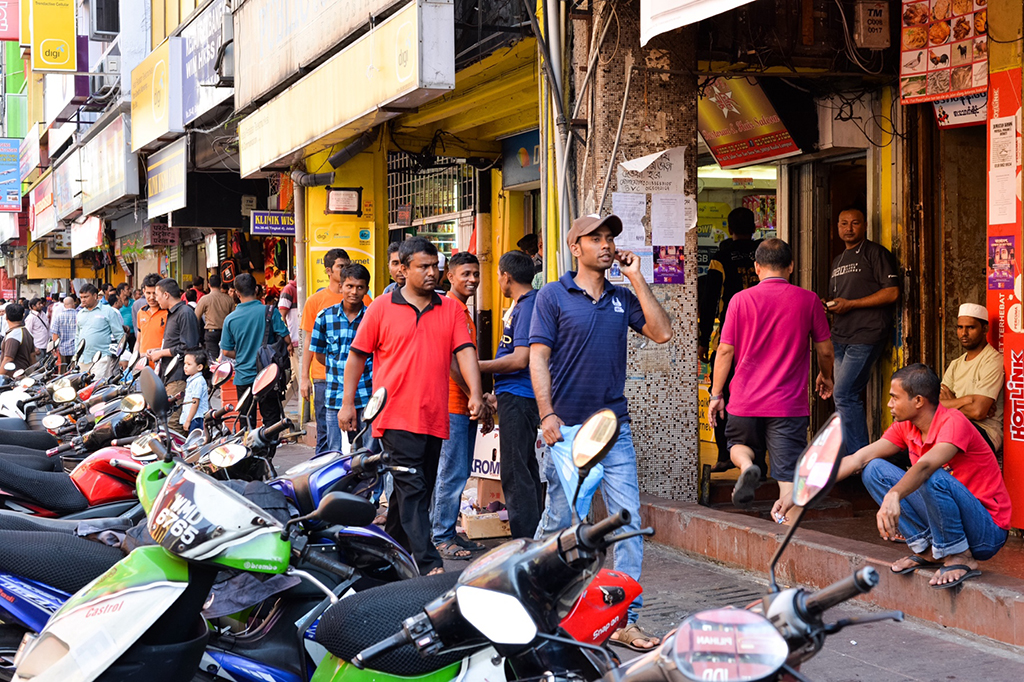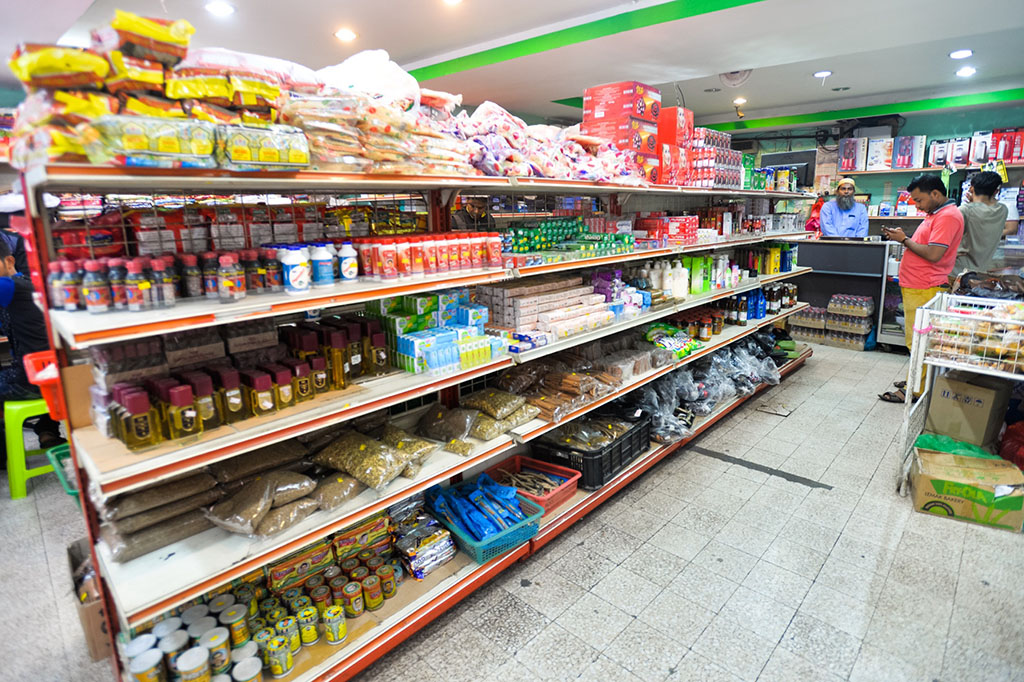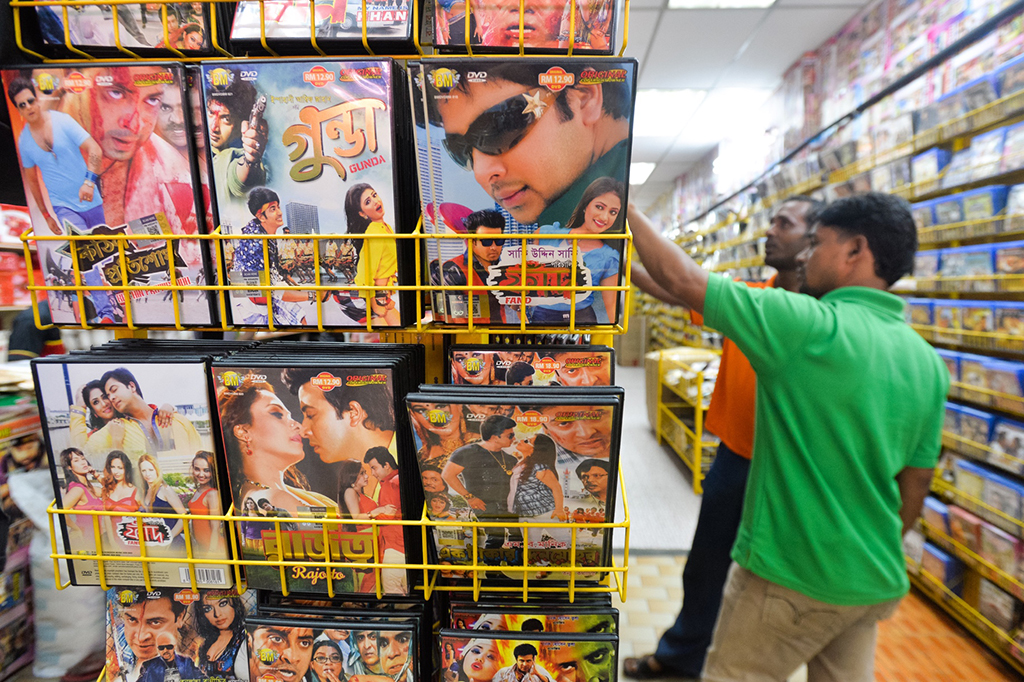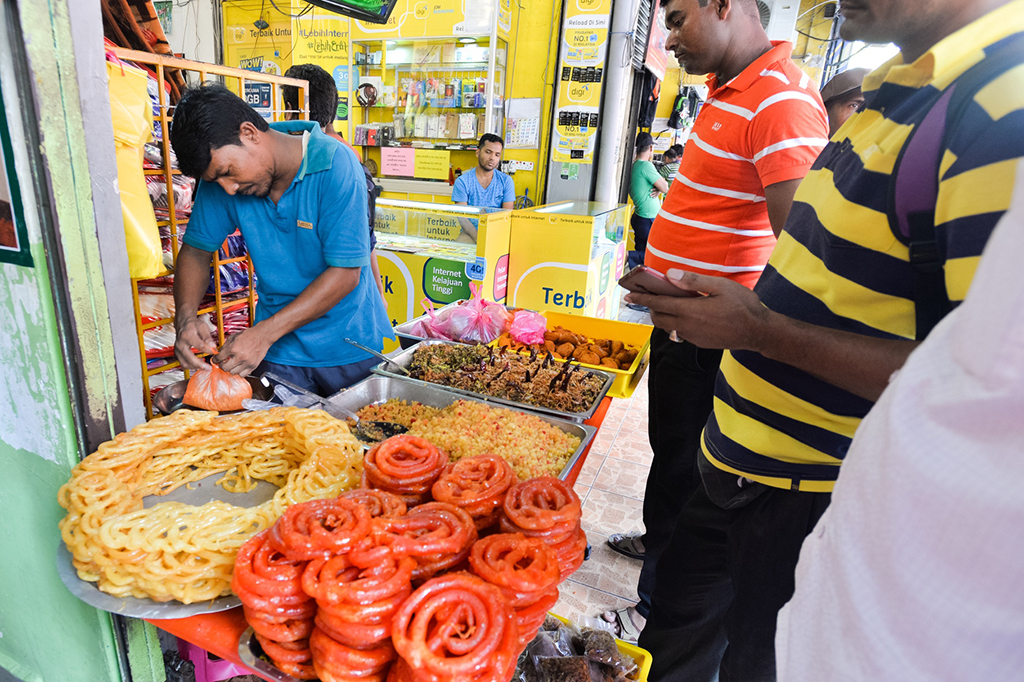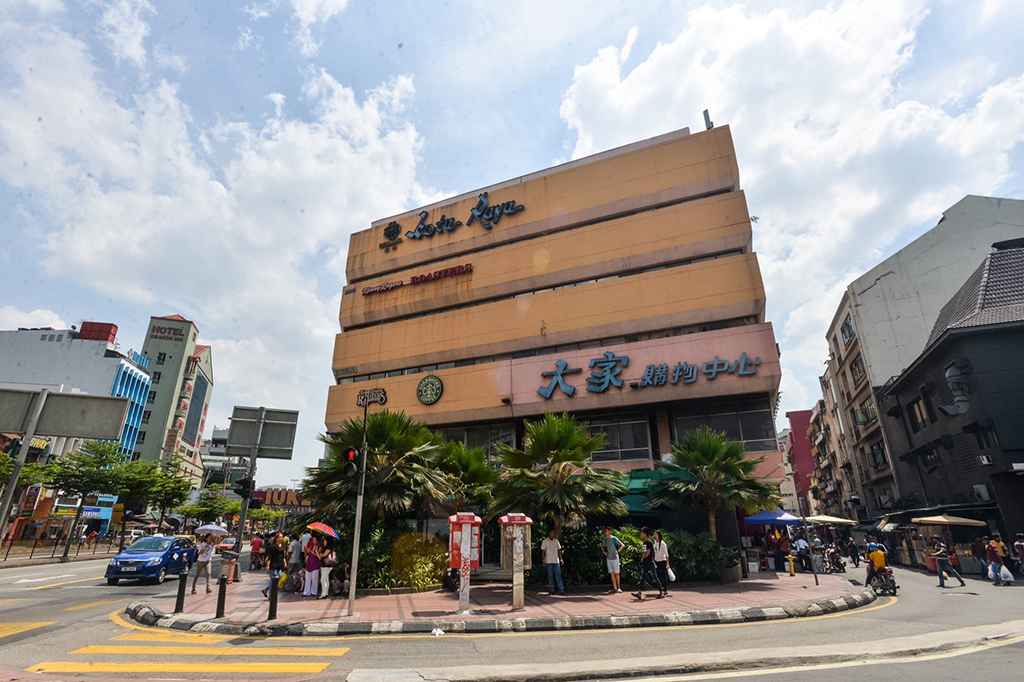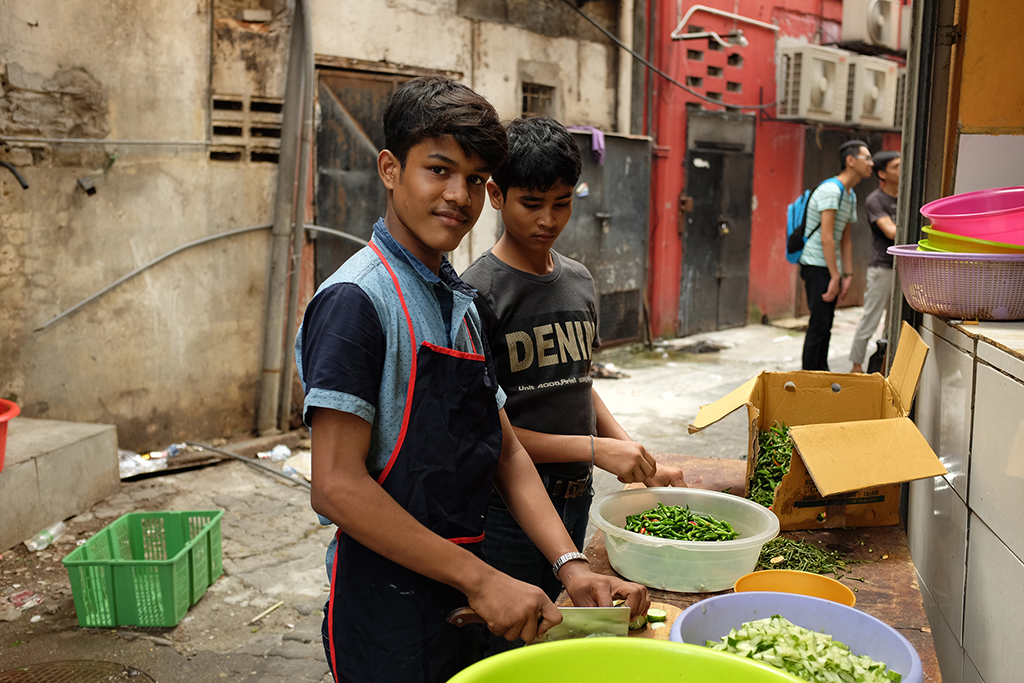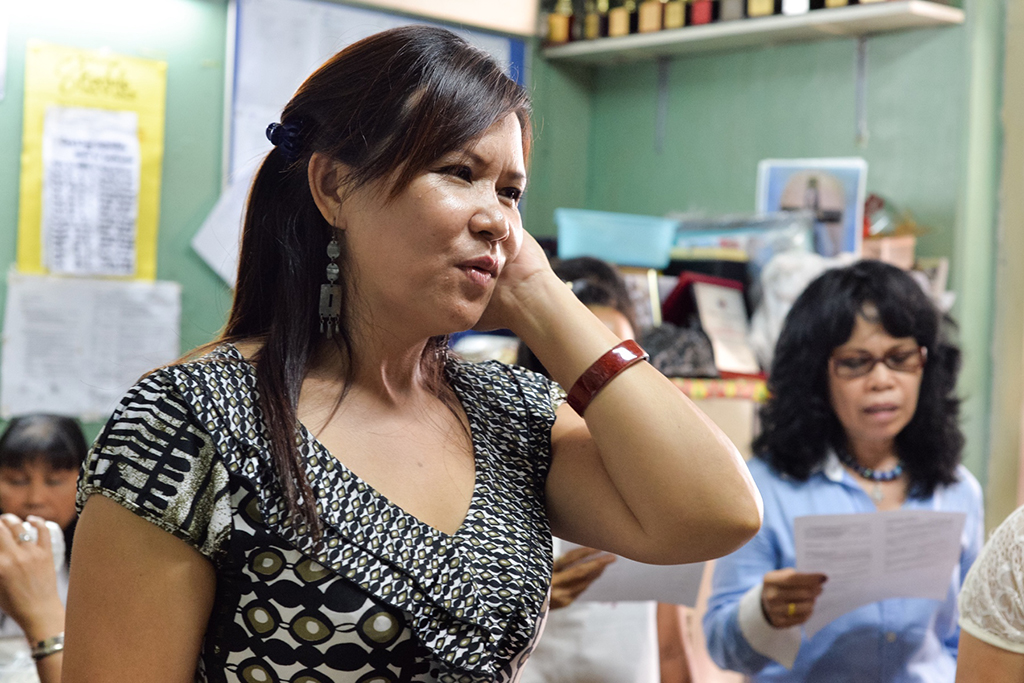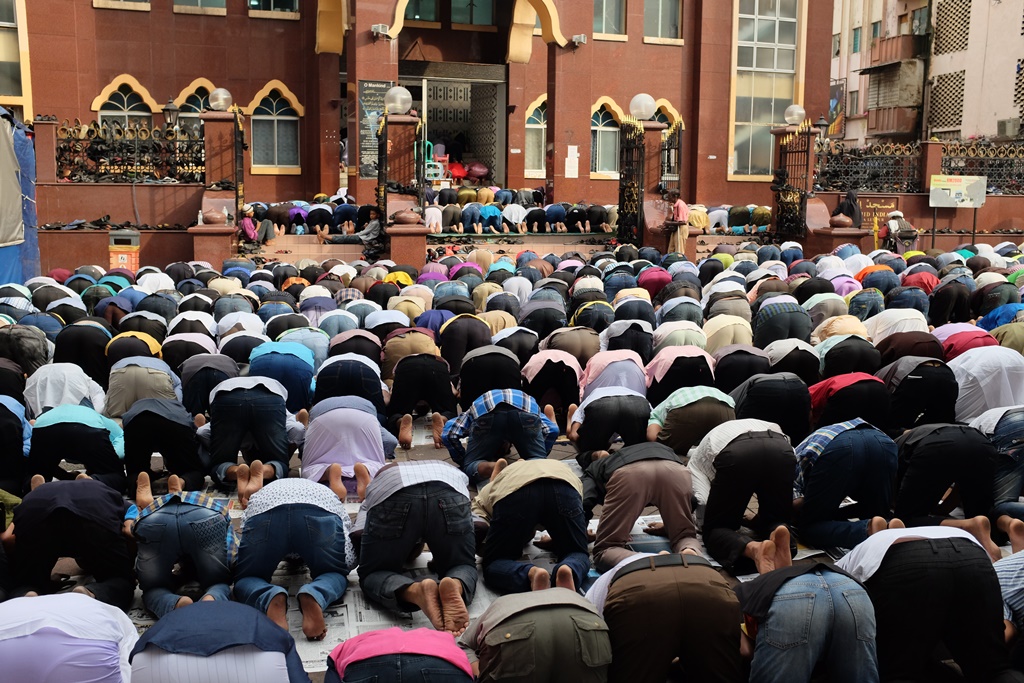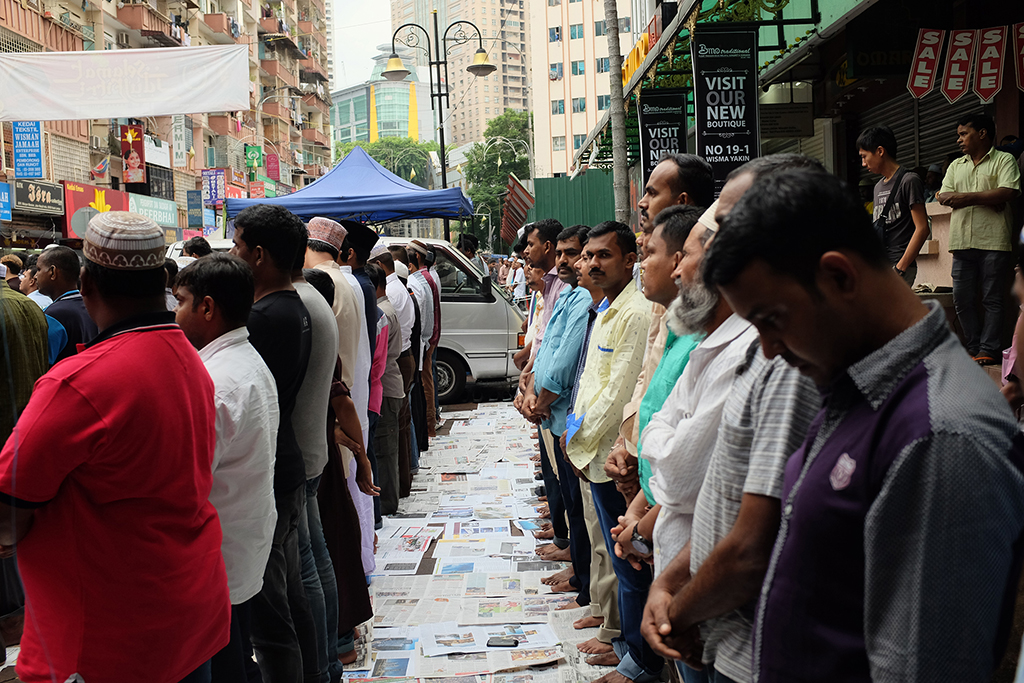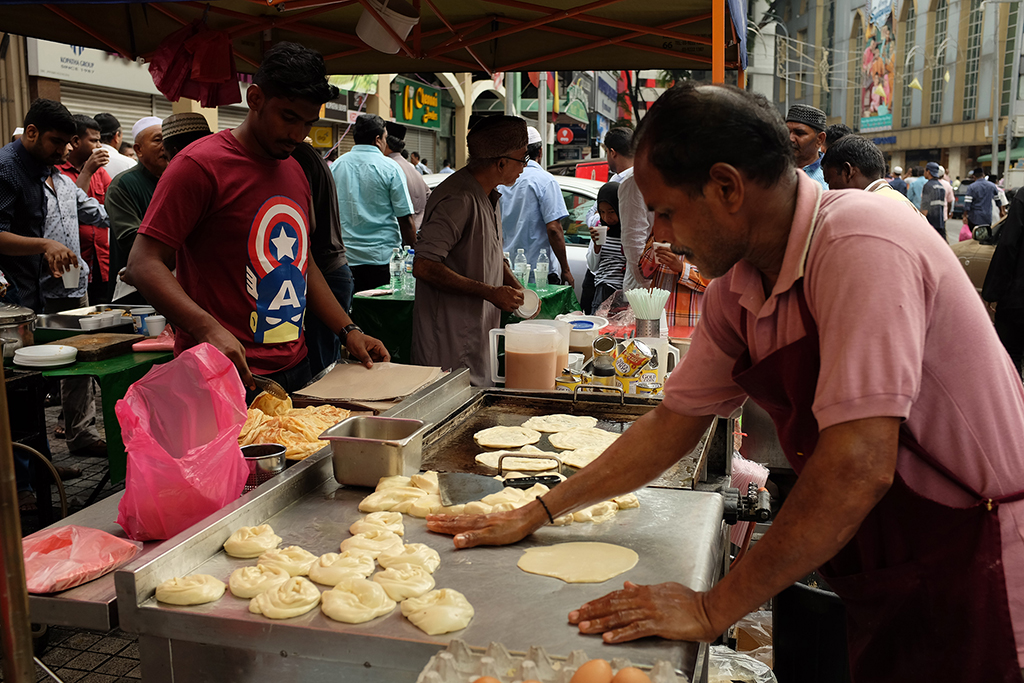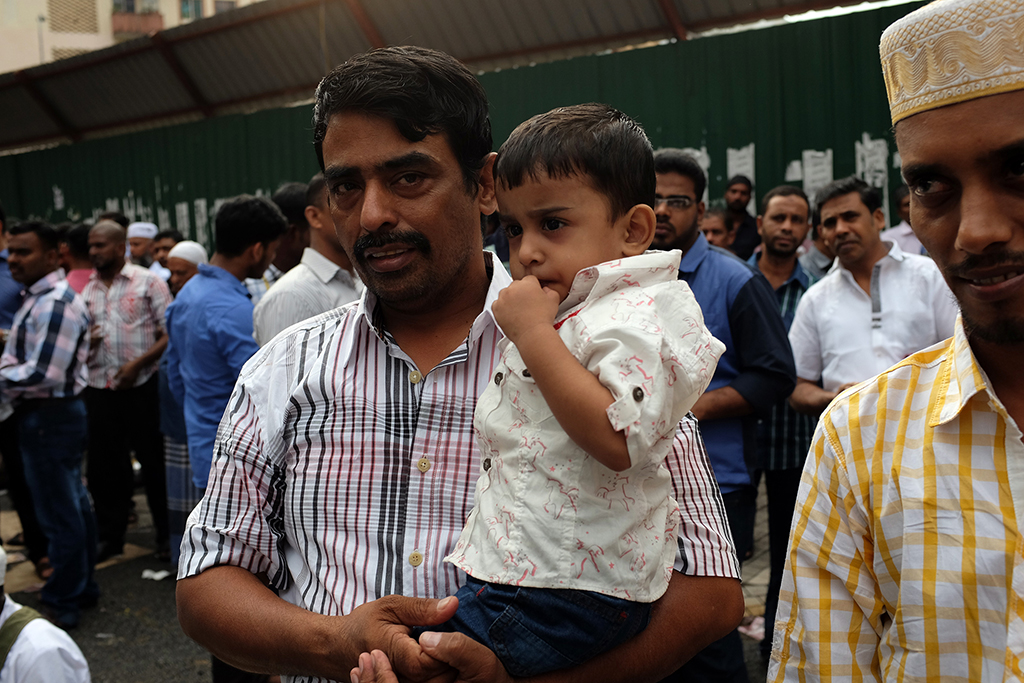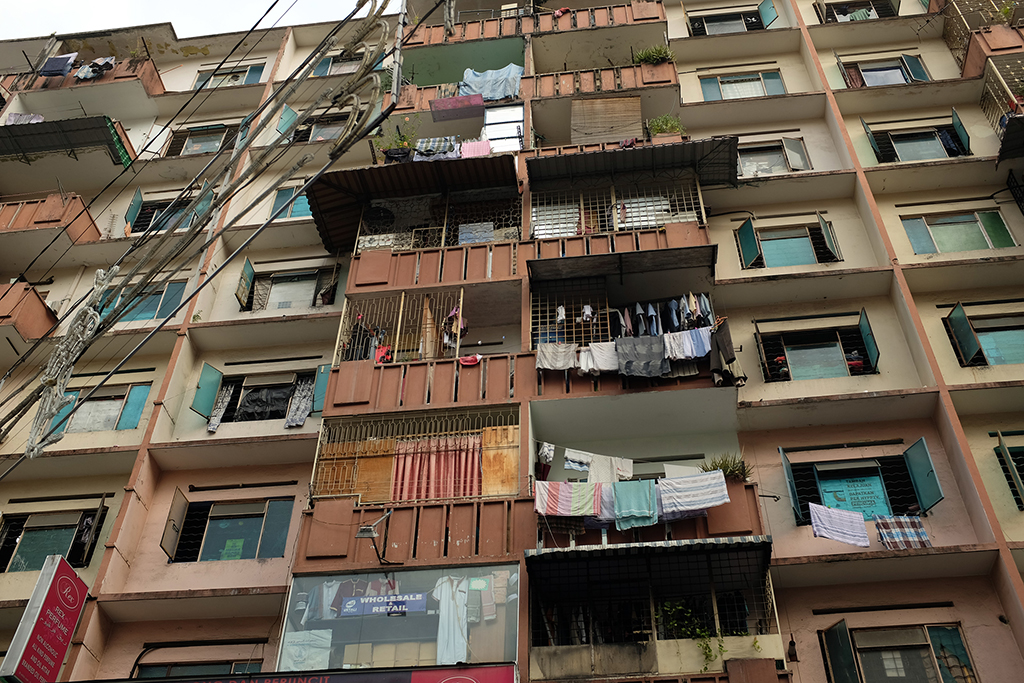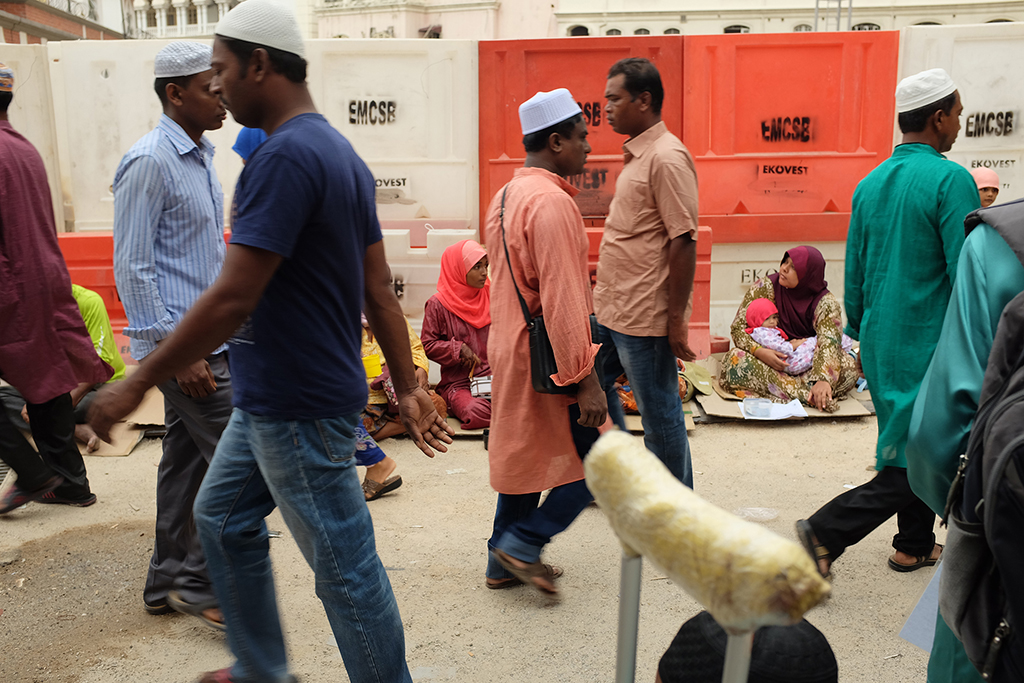Breathing new life into old streets
In the bustling city centre of Kuala Lumpur, if you walk through the front door of the Kota Raya Shopping Complex, turn left into a dusky corner, and you will see a small shop painted pink.
The wall of the shop is decorated with several posters of stylish models and large mirrors that reflect the face of the barbers and their customers.
This is a Filipino hair salon. The tiny shop is usually crowded during weekends, with customers sitting on chairs outside the shop, waiting for their turn for a haircut, manicure or foot massage.

On weekdays, there will be fewer customers. The hairdressers will chit-chat on the sofas outside the shops, making fun of one another.
If you happen to pass by during this time, they will greet you warmly, or even wink at you. If you try to run away from their teasing, they will burst into laughter.
Jemmy (not her real name) is an enthusiastic and humorous hairdresser. She always teases me and asks: “Can you be my boyfriend?”
I always replied with an awkward smile, then she will ask: “You can still be my boyfriend even if you have a girlfriend!” Then Jemmy and her friends will laugh out loud.
Looking out of the shop, you will notice a long queue in front of a remittance company.
This is where migrant workers send most of their salary back to their hometown, and they will use the remainder for their living expenses in Malaysia.


The second and third floors of the Kota Raya Shopping Complex is a Filipino girls’ shopping paradise. There are also a few Filipino restaurants where migrant workers gather.



Sometimes, they will use the karaoke machine in the restaurant to sing their favourite Filipino love songs.
If you continue to walk up to the fourth floor, you will see gaming centres, snooker rooms and internet cafes.
‘Bangla Market’
In fact, not only the shopping complex, but the area from the north of Petaling Street to the south of Jalan Yap Ah Loy is also where Burmese, Nepalese and Bangladeshi workers gather.
The whole area is referred to by migrant workers simply as “Kota Raya”, and has evolved into diverse and vibrant community where migrants spend their time and money.
When you walk out the Kota Raya Shopping Complex, and pass through to the bus station outside Mydin, you will come to Jalan Tan Siew Sin (previously named as Jalan Silang).
You will see the traditional Chinese shophouses on both sides have been turned into Bollywood DVD shops, blanket stores, travel agencies, remittance companies, grocery stores and Bangladeshi restaurants.
This street has been named the ‘Bangla Market‘.
One Nepalese restaurant which sells “Himalayan Cuisine” stands out from the rest on the street.
Ambi (not her real name) who helps her uncle to manage the restaurant said, “Nepalese culture is quite close to Bangladeshi culture.”
As such, it is easier for them to communicate with each other, hence there are some Nepalese living in Bangla Market, and most of them run catering businesses.

Sometimes, Ambi is annoyed by her customers: “After work, Nepalese workers will come here to drink beer; after they get drunk, they started to tease our female workers, or curse them with bad words.”
“Then I need to ask my male workers in kitchen to chase them out.”
There is a company called Malik Streams Corporation which has opened its sixth branch on the street. The owner also bought an entire building as their main office dubbed ‘Wisma Malik‘.
They sell different kinds of goods from Bangladesh, including soaps, spices and quilts, with the help of its workers from Bangladesh, India, Indonesia and other countries.
Malik Streams’ office building will be very busy during prayer times, as it has a surau in the building where Muslim migrant workers come to pray.
Continue to walk until the end of Bangla Market, and you will see a huge board with flags of countries from all over south and Southeast Asia.
This is where the telecommunication companies advertise their packages.
For migrant workers who come to Malaysia alone, they will need overseas calling packages to contact their family. Hence, migrant workers have become the most targeted customers of these companies.
Turn right in front of the advertising board, you will walk into a wider street; there you will see that the signboards are not in Bengali but Burmese.
Yes, this is Burmese street, where many Buddhists, Hindus and Muslims live and work side by side.
I saw a poster promoting haircuts outside a Burmese restaurant, and true enough I found a barber shop inside the establishment.
A woman in her 40s came out and asked in broken English:
“You want to cut hair?“
She is indeed a good conversationalist, her questions sound as if she wanted to investigate my background.
I understand that her name is Nadhin (not her real name). She walked across the Malaysia-Thailand border five years ago in order to escape from the civil war in the Kachin state.
When she safely arrived in Malaysia, Burmese Street in Kuala Lumpur became her safe haven.
I thought cutting hair in Burmese Street must be very cheap and didn’t expect that cutting and washing hair cost RM25 in total.
Price’ of belonging
Living costs in Kota Raya are very high: a cup of ice lemon tea can cost RM4, and the rental of a small shop unit is RM22,000. Many migrant workers find the high living expenses difficult to bear.
Even so, Kota Raya during the weekends or holidays is still crowded with migrant workers. We can see many migrant workers standing along the streets, chewing betel nuts, chatting with their friends in shops, and only leaving when the sky is dark.
Filipino worker Josh (not his real name) said even though the cost of Kota Raya is higher, he is more willing to come here than staying at home.
“During holidays I will come to the Kota Raya Shopping Complex because there are people like me or people with similar background as mine; they make me feel that I am not alone in this country.”
If you walk around Kota Raya, you will find that there are many migrant workers who have worked in Malaysia for decades, and many of them have started to run their own business, providing services for the migrant worker community.

Executive director of Tenaganita, Glorene A Das, explained that Malaysia’s economy developed rapidly during the 1990s, foreign enterprises came into our country for investments and many industries began to face labour shortages, especially in the plantation, manufacturing, construction and service sectors.
After they came to Malaysia, other than working for their employers, they will manage their own business during their free time, slowly accumulating capital and preparing to rent a shop.
“For example, in a construction site, there are only Chinese food or Malay food for them (migrant workers), as they have different eating habits; many hope to see dishes from their home countries.”
Glorene also pointed out that migrant workers miss their home and so they needed to buy things from their own country. Thus there will be many DVD shops, karaokes, grocery shops, import businesses and so on to cater to their needs.
When they earned profits, they need remittance companies to help them transfer money back to their homeland, so remittance companies have been established.
Thus, a community which focuses on migrant workers slowly took shape in Kota Raya.
On the other hand, this area is the nexus of Kuala Lumpur’s public transport system; migrant workers who came from other places find it easier to travel to Kota Raya.
To the east of the Kota Raya Shopping Complex is Pudu Sentral, a terminal for long-distance buses from the northern part of Malaysia; to the south-west of Kota Raya is the Pasar Seni LRT station and Kuala Lumpur KTM station, which are the main rail transport interchange for the capital city and nearby areas.
Buses which stop in front of the Kota Raya Shopping Complex and Mydin are medium-distance buses from Klang, Seremban, Rawang and other places, while the short-distance buses which travel in Petaling and Kuala Lumpur will stop at the Pasar Seni LRT Station.
A free bus service provided by the Selangor state government also allow migrant workers to travel to Kota Raya from the LRT station.








Glorene recalled, when she was still young, the Kota Raya Shopping Complex was like today’s KLCC – it was the city centre of Kuala Lumpur, and the place for young people to gather and go shopping.
“After some time, this shopping mall fell out of favour; it was overtaken by newer malls. Locals didn’t go to Kota Raya anymore; then this shopping mall and its surrounding areas began to be the gathering place of migrant workers,” she said.
Migrants want a better life
In fact, migrant workers are like the locals: they all hope to live a better life and find a sense of belonging in the community they are attached to. They do not wish to face exclusion.
When a Chinese shopkeeper from Petaling Street is being interviewed, she said: “They (migrant workers) also need to look for their livelihood, very similar to the Malaysians who went to other countries to work; everyone is hoping to get a better job.”
Walking along Petaling Street, I can’t stop but think about the history of the Chinese migration. I notice that the conditions of the migrant workers and the ancestors of the Chinese who travelled to Southeast Asia are extremely similar.
During the end of Qing dynasty, the British colonial government was developing the mining industry in Malaya and it needed manpower. The Chinese came to work as coolies in the mines.
And now, driven by global capital and market forces, migrant workers from different backgrounds are flocking to Malaysia, yet again.
For several decades, Petaling Street and Kota Raya were the gathering places of Chinese migrants, and those places eventually became Chinese communities with their own characteristics.
According to a book named ‘The History of Kuala Lumpur’s Chinese‘ written by Wen Guzhi, Kota Raya today was a gathering place of Chinese migrants before.
“……The area near Jalan Silang is also known as ‘The Flower Street’, Flower means prostitutes…”
“There was a triangle-shaped open space in Jalan Tun Tan Cheng Lock, which is now the Kota Raya Shopping Complex, it was bazaar with a row of stalls.”
When the development around the Kota Raya area became saturated, the city centre began to shift; the economic and business zones began to expand to surrounding areas, while Kota Raya slowly became a Chinese traditional community, abandoned by the locals.
When most of the Chinese moved out, the houses and shops of Kota Raya were rented to migrant workers, and became an enclave in the middle of the city centre, for migrant workers to build their life, and helped Kota Raya regain some of its lost economic lustre.
Bikek (not his real name) is 19 years old and works at a fast food restaurant in the Kota Raya area. He wears earrings, has a big tattoo of a rose on his arm, and is dating a Filipino girl he met through text messaging.
But Bikek‘s girlfriend, a domestic worker, can only take a day off once a month and each outing lasts just four to five hours at a time.
When asked what they normally do on their dates, a smile spreads across Bikek‘s face.
“We will find a hotel near Kota Raya and rent a room for three to four hours, and do bad things,” said the Nepali teenager with a glint in his eyes.
But Bikek shook his head when asked about his future plans, and whether he will go back to Nepal or to the Philippines with his girlfriend.
“We don’t know what we are going to do in the future, we don’t dare to think about it,” he said.
It is difficult for migrant workers to have a stable relationship, let alone a future to look forward to.
Filipino hairdresser Jemmy is the only member of her extended family who isn’t married, nor does she have a family of her own to take care of.
For her, the best choice was to go overseas in search of greener pastures.
Jemmy’s family relies on her to earn money in Malaysia and send it back to them; only then will her nephews and nieces have a chance to study.
Left with no choice but to leave her hometown, she broke up with her lover of many years.
As we spoke, Jemmy would often ask, half-jokingly: “Can you introduce me to a nice guy?”
“You haven’t met one after so long in Malaysia?” I asked.
Jemmy sighed. “People here are different from Filipinos, it is so hard to find a local who can understand us.”
Let me sing you a song from my homeland ♫


Comfort from songs of praise ♪
Filipinos who gather around Kota Raya are mainly female, and most will participate in church activities, trying to find peace through their faith.
Lussie (not her real name), 35, has two children back home in the Philippines and currently works as a domestic worker for a local family.
On Sundays, Lussie goes to St John’s Cathedral to pray. After service ends, she attends classes organised by the church, which include yoga, guitar lessons, nursing and modern dance lessons. Gifted with a voice, Lussie decided to join the choir.






Once lessons are over, she helps massage her friends; many female Filipino workers do housework from morning to night, leaving their bodies and muscles aching, said Lussie.
Lussie said she learned basic massaging skills from a class at the church, so her friends often come to her with their aches and pain.
On the day I spoke to her, Lussie stayed back in the classroom. Once everyone had left, she picked up a guitar and began to sing a lovely Filipino song.
“What is this song about?” I asked.
Putting the guitar down, she told me in her soft, gentle voice: “This song is called ‘Napakasakit Kuya Eddie’ (Eddie my friend, my heart is painfully hurt). It tells the story of a Filipino who works hard in a foreign country, while always missing his hometown.
“But when he finally returned home, he found that his two sons had become drug addicts, while his wife met a new guy, and even bore a child with her new lover.”
“Looking at the broken family, he asked his friend Eddie: ‘Bro, what should I do?’”
As Lussie resumed her singing, her sadness was apparent, even though I did not understand the words.
A sermon in Tamil
Religious buildings such as the historical Masjid Jamek, Masjid India, and St John’s Cathedral, can all be found in Kota Raya. Many migrant workers gather there during holidays or religious festivals.
On Hari Raya, Indian national Shuleh (not his real name) travelled from Banting to Kuala Lumpur, where he works in a mamak restaurant.
Normally, he wakes up early in the morning to prepare food for the restaurant’s patrons.
But on Hari Raya, he dressed up in his new clothes, donned a new songkok and slippers, and left for Masjid India at around 8am with his friends.


There are few vehicles and pedestrians on the road during Raya. As Shuleh walked to Masjid India, Muslims from all over Kuala Lumpur had already flooded the street in front of the mosque, waiting for Raya prayers.
Most Muslim Indian and Pakistani workers flock there to pray because the mosque delivers its sermon in the Tamil language, according to Shuleh.
After prayers, they linger on the street, hugging, chit-chatting, and taking selfies with family and friends whom they haven’t met in a long time.
On that special day, they do not mind the hours it takes to commute to pray in Masjid India, said Shuleh.
Besides, they get the rare chance to go shopping in Bangla Market, or visit tourist spots like KLCC or Batu Caves, he added.


Bangladeshi worker Ibrahim (not his real name) had asked for leave in order to travel from Terengganu, where he works, to his friend’s house in Bangla Market, Kuala Lumpur.
He feels at home when he is at Bangla Market, as he can finally eat Bangladeshi food, see familiar faces and hear familiar words.
Most importantly, he does not feel excluded.
After prayers, I followed the crowd to the Selangor Mansion.
The Selangor Mansion
An old building, the Selangor Mansion‘s first floor houses an Indian mamak restaurant and several stalls selling an assortment of items, from Indian magazines to fruits.
This place also has the best roti canai in town, or so I heard.
Following the crowd into the building, I was met with a pungent, spicy smell, mixed with a slightly uncomfortable stink.
The peculiar smell led me to a staircase to the second floor. It became stronger as I found myself in a nine-floor apartment complex, its upper floors crammed with people.
In front of me was a platform teaming with garbage. Men, half-dressed, sometimes walked through the apartment’s corridors to throw rubbish onto the platform; others spat from the upper floors.
The Selangor Mansion‘s first and second floors house grocery shops, barber shops, offices and mamak restaurants – all of life’s necessities packed in the two levels.
I asked some Bangladeshis lounging in the corridor how much their rental cost. Their answer took me aback. The small, substandard rooms can cost up to RM500 per month, which they share with three to four roommates per unit.
Makeshift stalls on the streets
Malaysians complain about the falling ringgit and soaring living costs, yet migrants who send money to their hometowns are hit just as hard.
Many have taken on part-time jobs to earn more money. Some of them unfurl big, red cloths on the streets, opening makeshift stalls that sell snacks, fruits, medicines or second-hand clothes.
Outside the Kota Raya shopping complex, Malay women could be seen holding bags containing medicine; Filipino women passing by them would pause to buy their wares.
“Many Filipinos females perform housework every day, in the end they lose their appetite, so they buy appetite-enhancing drugs from us,” the sellers said.
Sometimes, an elderly Muslim man with a white beard, dressed in a white rob, could be seen sitting on the streets, waiting for customers.
His movements drew the attention of passers-by; many migrant workers gathered around him in a circle, as if watching a street performance.
One migrant worker explained to me that the man was helping them get rid of the acne on their faces.
Meanwhile, Bangla Market has many stalls selling betel nuts; sellers will paint some white lime on top of the leaves, roll them up and fill them with spices.
However, they often run into trouble with municipal enforcement officers. Forced into a corner, they usually hand over some cash in the hopes that the officers will leave quietly.
Threats and violence
But for undocumented migrant workers, it doesn’t matter whether they are involved in illegal businesses or not – they constantly worry about being harassed by enforcement officers.
Burmese Nadhin came to Malaysia to escape the fighting in Myanmar, but she didn’t manage to get a refugee card, never mind a valid working permit.
She joins one of the most vulnerable groups in the migrant community: the undocumented immigrants.
Each time her employers exploit her or officers harass her, Nadhin can only swallow the bitter experience.
“When we walk on the street, officers will stop us, they request us to hand over our money. If not, they will search our handbags until they get enough money.”
“If they meet male workers, they will search their bodies, sometimes they will ask those guys to take off their pants, to make sure that they didn’t hide money inside their underwear. If the officers can’t get enough money from them, their handphone will be taken away.”
He said many Burmese working in foreign countries were delighted by the regime change in Myanmar, and hoped it meant they could return home sooner.
“We all look forward to the government led by Aung Sang Suu Kyi, we will observe for a few more years, if the situation in Myanmar becomes better, we will go back.”
Nepalese Bikek hopes to leave Malaysia for richer countries, such as Japan or South Korea, where he believes he will receive better pay, allowing him to return home earlier.
The falling ringgit, the worsening public security, and fears for their safety make Malaysia an undesirable place, he said.
Shuleh said many of his friends had gone to work in countries that were more friendly to migrant workers, such as Saudi Arabia.
The Malaysian government prohibits migrant workers from bringing their family members along, and employers don’t encourage them to visit their home country, he said.
Ah Hao (not his real name) works in Klang but comes to Kota Raya during the holidays.
Nadhin said migrant workers are not only targeted by enforcement officers; they often face harassment from local taxi drivers and gangsters.
“When we take the taxi, some drivers will ask us to hand over our money and handphones, or they will lock the doors and not allow us to get off.
“When we walk on the street we get caught, when we take taxi we will face robber-like drivers, where then can we go?”
Kota Raya may be like home for them, but they still face threats and harassment each day.
The staff at the barber shop, Lily and Merry (not their real names) said:
“This place (Kota Raya) is no different from other places; maybe the safest place for us is Myanmar.”
Robots deviod of feelings & desire
PSM deputy secretary-general Choo Choon Kai said problematic policies on migrant workers left them with their hands tied.
Although Malaysia’s laws allow migrant workers to file legal claims for compensation, those who are sacked immediately become undocumented workers.
This requires them to apply for a “special pass” from the Immigration Department, in order to stay in Malaysia and continue their suit.
But that pass prohibits undocumented workers from finding another employer, robbing them of the chance to earn a livelihood.
This is why migrant workers would rather face exploitation from employers than take action against them, he said.
Choo said locals often viewed migrant workers as robots – tools devoid of desires and feelings, made to be easily exploited.
“Malaysia’s labour laws should be covering all workers, but migrant workers who signed contracts with their agents are gradually restricted from exercising their rights.”
“These contracts don’t allow migrant workers to join unions or get married, literally treating them as robots.”
“Our migrant worker policy is just like how the British colonial government governed the Chinese, Malay and Indian workers during the colonial period, treating them as disposable tools that will be thrown away when they are all used up.”
– Choo Choon Kai
The unseen women in Kota Raya
Standing anywhere around the Bangla Market, one can see many young men. Sometimes you may come across elderly men or even kids, but you can’t find any women on that street.
Executive director of Tenaganita Glorene A Das said female migrant workers who come to Malaysia are mainly involved in sales, service industry, or the sex industry.
In a community where the Burmese and Filipinos gather, there are female barbers, domestic workers or saleswomen.
However, we can’t seem to find a girl or a woman in Bangla Market.
There is a Bangladeshi guy, Rashid (not his real name), who has set up a stall in Bangla Market. He always sits in front of his stall, calling passersby to buy snacks from Bangladesh.
Asked why we can’t find any female migrant workers in Bangla Market, he said people from Bangladesh come to Malaysia to do tough jobs, which are not suitable for women.
Rashid also complained that the Malaysian government doesn’t allow migrant workers to bring their family along, thus the Bangladeshi men have to come alone.
Then Rashid gave me a strange smile and said: “But if you want to find Bangladeshi amoi (women), then you need to go to that place.”
His finger pointed at a shop opposite the street. It is the second floor of a traditional Chinese shop, completely sealed by old wooden windows. Downstairs, it is a normal Bangladeshi grocery shop. And beside the shop, there is a dark staircase with red lights.
There were two men outside the staircase. One of them is a Chinese who was sitting on a chair indolently and another is a Bangladeshi who beckoned his hand towards the passersby, repeating some Bangladeshi words and appeared to call the passersby to visit his shop.
Asked about the place, the Bangladeshi man said in his broken English: “This is a ***** place, go, you can ****.”
When queried about the women who works there, he raised his head and told me proudly: “There are women from everywhere! Bangladesh, Pakistan, India, Indonesia, Myanmar … this is a very international place.”
Then he continued: “Today is Raya holiday, there are so many customers today. People keep walking up the stairs, never stop.”
Upstairs looked busy. The women don’t have to celebrate Hari Raya? He sneered, never replied and continued to wave his hands, looking for potential customers.
Old women, abandoned bodies
Attracted by the calls, many went up to the second floor. Inside, they would see mysterious pink lights, just like in movie scenes.
One Bangladeshi came. He stood and looked, probably unable to make up his mind.
There are many small rooms there and outside each room, there were women with heavy make-up, wearing revealing clothes.
The women stood outside their rooms, held their breasts, and asked: “Want (Mau tak)?”, “RM40, can?” The men were just standing there, pondering on their choices.
The house is divided into front, back and the attic. The young and beautiful women will stay in the front rooms, older ones stay in the back rooms and the attic.
Aged women wore sarees and gorgeous accessories, with thick make-up. They would ask “Just RM20, can?” or “Wanna try?”. They would try harder in enticing the men, holding their hands and sometimes drag the customers to their rooms.
When the men choose the young and pretty ones, one can see the look of disappointment on the older women.
The pimps are the most important characters at the brothels. There are always two or three of them, sitting or standing on the street, persuading the migrant workers to walk into the dark staircase behind them.
Pimps in Kota Raya are mostly Chinese or Bangladeshis. They are placed in the middle position within the power structure of the brothels. They answer to the owners of brothels (or human traffickers) and are also in charge of the sex workers.
They are very busy. When the customers walk to the stairs, the pimps will follow them, telling the customers “She is not bad, just RM30, okay?” or “She is good, you will look for her again once you try!” Just like selling livestock.
If anyone challenges them on the cleanliness of the place or whether condoms are used, they would reply: “Of course we use condom, condom good, need to play safe mah!”
Bound by debts
Nilah (not her real name) who came from India, is 27 years old. She is a divorcee with two young kids.
In order to solve her family’s economic crisis, she asked her mother to take care of the kids and she came to Malaysia alone, hoping that she will find a good job through agents.
When she first came to Malaysia, she worked as a cleaner, but soon she found the job not as what her agent described. The agent had promised Nilah that she would work five days a week, but the cleaning company only allowed her to work for two days.
Nilah could not make enough money, not enough even to eat. She just wished she could leave and go back home. But she can’t because of the debts she owed the agent, which binds her.
Then the agent suggested to Nilah to try the sex industry. Sex workers don’t have to worry about their livelihood and they can pay their debts in the shortest period of time.
Out of desperation, Nilah consented, and she prayed that she could survive the three months.
Nilah began to receive customers, in the small and smelly room. She had to serve five to 10 men a day. When she has no client, Nilah will stand in front of her room, soliciting for customers.
She will provide the services and the pimp will collect the money from customers.
The pimp will haggle with the customers – RM20 for sexual intercourse, an extra RM10 for taking off her clothes, and another RM40 for “ice-cream service” (blowjob).
But Nilah won’t get a cent. Half will go to the owner of the brothel, and the rest to Nilah’s agent. Nilah will get extra money only if her customers pay her tips. She will give that money to the pimps who will buy her food.
Even on her off days, Nilah would not leave the dusky building. At night, she can’t even sleep in the room she works because the brothel runs 24 hours a day.
There will be another girl working in the same room for the night shift. So Nilah and other girls will be squeezed into a crowded and closed room.
About her future, Nilah said helplessly: “I don’t have any idea, I just want to pay the debts and go home.”



Sex industry to baby factory
Glorene said Nilah’s story is just the tip of the iceberg. The sex industry in Malaysia is growing rapidly and the country is a transit for human trafficking in this region.
Glorene (photo), who has been in touch with several victims of human trafficking, said: “They came through human trafficking or syndicates. Sometimes after they come here, the life is tough, their husbands will ask them to go and do sex work. Sometimes when the girls think that they cannot perform very well in housework, and they don’t have money, the agents will suggest them to do sex work.
“Out of desperation there are some girls who will do it voluntarily, but some of them are being forced because there is high demand, from our own men and women, and tourists.”
If these women get pregnant, what will happen to them? Glorene said previously the pimps would force them to abort. But lately, there have been changes – some customers look for sex with pregnant women.
Hence the pimps will ask the pregnant women to continue working.
“Babies born will be sold for high prices in the black market. Parents who are looking for babies will buy from them. Eventually, the sex industry leads to baby factory,” Glorene said.
Some of the kids will be raised by the pimps. When they grow up, they will be trained as sex workers.
Glorene said: “I don’t know why, but there is so much of kinky sex in our society. Even child sex is getting popular.
The market for child sex is growing in Malaysia. Children below the age of 12 are the main targets. For the pimps, children are easier to train.
Glorene said a convicted trafficker once told her that,
“Once a drug is sold, it is sold; once a weapon is sold, it is sold. But human beings, they can be used and used”.
Compared to men who have more autonomy, many female migrant workers are locked up inside darkened rooms.
Cultural mapping
Through the cultural mapping of migrant workers in Kota Raya, we saw a fluid community which is full of energy, but we also saw its dark corners.
The Chinese came to British-ruled Malaya as migrants.
And every morning, many Malaysian workers travel to Singapore to seek a better life.
Unfortunately, we always, unconsciously, forget the origin of “migrant workers” and pretend like we are “natives”.
We claim we are owners of the land and begin to exclude the “migrant workers” who came later.
Many people have described Kota Raya as being “invaded” or “colonised”. But when they consider themselves as “victims”, they can be “oppressors” as well.
South Asian and southeast Asian migrants are being discriminated. They are despised as being “lower working class“.
But we look up to foreign talents in upper class positions and label them “expats“.
Are we all not human beings, wishing and working for a better life?
Like this article?
Share it with your friends.

